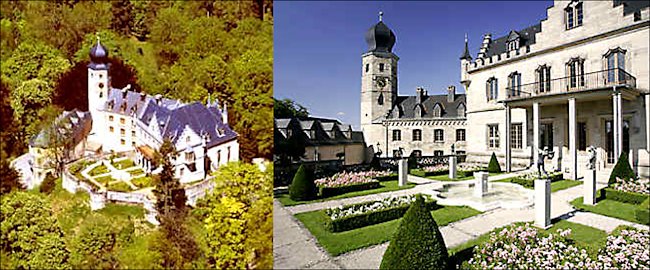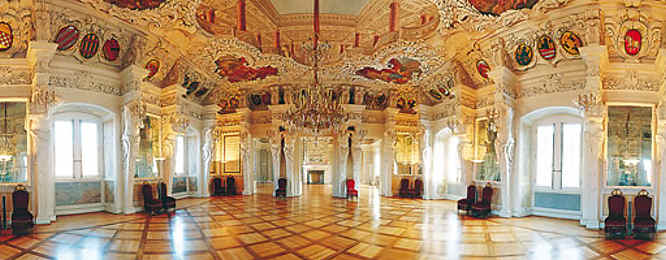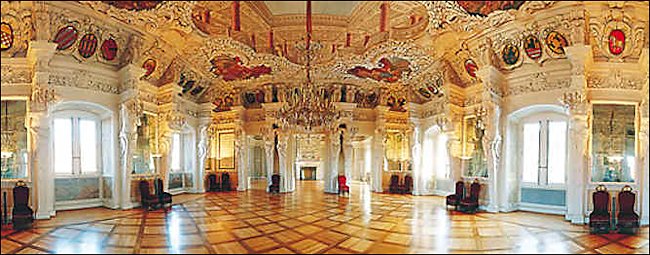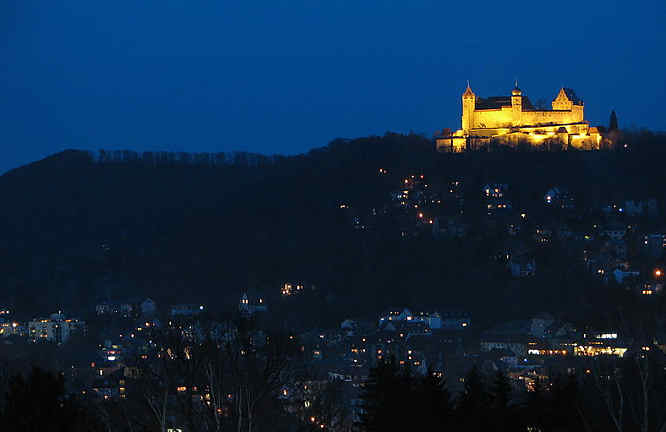Coburg's Schloss Callenberg
Prince Albert's brother lived in this castle. Queen Victoria and Prince Albert visited the castle a number of times. It is very different to their Schloss Rosenau. It is built high on top of a large hill among the Callenberg Forest. There are lots of good walks in the surrounding countryside that start from the car park. Although it looks very medieval it is in fact quite new.

Between 1831 and 1857 the Dukes Ernst I and Ernst II. of Saxe-Coburg and Gotha carried out radical rebuilding on top of the existing 12th century fortress. The resulting three winged fairy tail castle was built in the Neogothic style of architecture that was very popular in Germany and Britain at that time. Until 1945 the castle was the summer residence of the Dukes of Coburg. The Castle of Callenberg is about 6 km north west of Coburg and can be reached by the B303 and B4 roads. It takes about 15 minutes to drive there from the city and is worth the effort.

Coburg's Schloss Ehrenburg
This is the third palace in Coburg. It is much bigger than the Schloss Rosena and Schloss EhrenburgSchloss Callenberg. Schloss Ehrenberg is in the center of the city. It is a 'marmite' palace: you either love the stark neo-Gothic architectural style or hate it. Although built in 1547 it was it was greatly remodelled after a fire in 1690.
It was the Dukes of Coburg's official town residence from 1547 to 1918. It's an astonishingly lavish, Buckingham Palace sized building. It has intricate parquet floors laid in each room and tapestries line the walls. The most impressive chamber is the Hall of Giants, a state room dating back to the 1690s which takes its name from the 28 muscular male figures carved from stone who appear to support the Baroque-style stucco ceiling.
The Hall of Giants was where Prince Albert was confirmed; and Queen Victoria's mother and father, Princess Victoria and the Duke of Kent, married. There is also a plaque marking the 1863 meeting in the room between Queen Victoria and the Emperor of the Austro-Hungarian Empire, Franz Joseph.

Upstairs are the quarters which were reserved solely for her use. They appear to have changed little since her last visit in 1894. The piano she played still occupies her living room while a painting of Windsor Castle was there to remind her of England.
The Castle Fortress Veste-Coburg
On the other side of the square in front of the palace Schloss Ehrenberg are the steps leading to the bottom of the Hofgarten or Royal Garden. It is a very large and beautiful green space which has a path that leads up hill to the 'Veste' which is short for 'Festung' which means fortress.

It is a lovely long walk which is not too steep, but it is still uphill for 30 to 40 minutes. Take care on the paths in winter, as some of them can be very slippery. The Veste-Coburg fortress dominates Coburg, and can be seen from almost every street. It is Located on top of a hill overlooking the town.
It looks impressive when lit up at night. The main buildings of the fortress itself were built in the 16th century, but parts of the castle date back to Gothic and even Roman eras. The fortress was home to Martin Luther for a number of months in 1530, when Nuremburg refused to let him in during the Augsburg Debates. For those that do not want to or cannot walk up to the top of the hill, there is an hourly Bus to the fortress

Travel books

